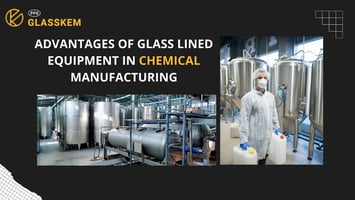The Environmental Benefits of Glass-Lined Process Equipment

In today's world, where environmental concerns are more prominent than ever, industries are actively seeking ways to reduce their ecological footprint. One innovative solution that has gained traction is the use of glass-lined process equipment. As a leading Glass Lined Equipment Manufacturer in Canada, we recognize the pivotal role this technology plays in promoting sustainability. In this blog post, we will delve into the environmental benefits of glass-lined process equipment and explore why it's a wise choice for industries looking to minimize their impact on the planet.
The Green Revolution with Glass-Lined Equipment
Glass-lined equipment, including reactors, tanks, and vessels, has become increasingly popular in various industries for several compelling reasons. First and foremost, these products are designed to withstand corrosion and degradation, ensuring a longer lifespan compared to conventional alternatives. This durability translates to fewer replacements and less manufacturing waste, contributing significantly to a greener manufacturing process.
Reducing Resource Consumption
One of the key environmental advantages of glass-lined process equipment is its ability to reduce resource consumption. As a Glass Lined Equipment Manufacturer in Canada, we understand that industries must minimize their resource use to protect our planet's finite resources. Glass-lined equipment can last for decades, requiring fewer raw materials for replacements. This translates into fewer trees cut down, less metal mined, and reduced energy consumption in manufacturing.
Lower Emissions and Chemical Leaching
Glass-lined reactors and vessels are known for their excellent chemical resistance. This property is not only essential for the efficient containment of various substances but also for reducing emissions and the risk of chemical leaching into the environment. By choosing glass-lined equipment, industries can prevent the release of harmful chemicals into the air or soil, thus safeguarding ecosystems and human health.
Energy Efficiency
Energy efficiency is a critical aspect of environmental sustainability. Glass-lined process equipment contributes to this aspect by requiring less energy for temperature control. The glass lining provides excellent insulation, reducing the need for constant heating or cooling. This results in lower energy consumption and a smaller carbon footprint, making it a preferred choice for environmentally conscious industries.
Waste Reduction and Recycling
The longevity of glass-lined equipment not only reduces resource consumption but also minimizes the amount of waste generated by industries. Fewer replacements mean less equipment ending up in landfills. Moreover, glass-lined materials are recyclable, further reducing their environmental impact. This aligns perfectly with the principles of a circular economy, where resources are conserved, reused, and recycled to the greatest extent possible.
Conclusion: Leading the Way as a Glass Lined Reactor Manufacturer
In conclusion, the environmental benefits of glass-lined process equipment are undeniable. As a Glass Lined Equipment Manufacturer in Canada, we are committed to advancing eco-friendly manufacturing practices. By choosing glass-lined equipment, industries can reduce resource consumption, lower emissions, and promote energy efficiency. It's a sustainable choice that not only benefits businesses but also helps protect our planet for future generations.
At PFG Glasskem, we take pride in our role as a leading Glass Lined Reactor Manufacturer. We invite industries to join us in this green revolution, where environmental responsibility and cutting-edge technology go hand in hand. Together, we can create a more sustainable future while still meeting the demands of modern industry. Make the switch to glass-lined process equipment today, and let's build a greener tomorrow.
READ MORE :- How Glass-Lined Equipment Enhances Pharmaceutical Manufacturing



